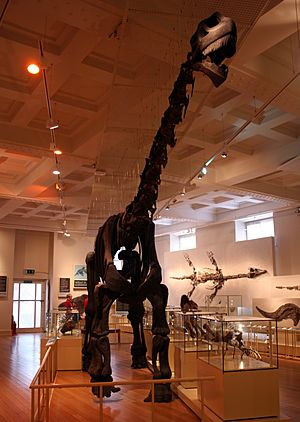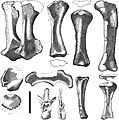Cetiosaurus facts for kids
Quick facts for kids Cetiosaurus |
|
|---|---|
 |
|
| Mounted skeleton, New Walk Museum | |
| Scientific classification | |
| Genus: |
Cetiosaurus
|
| Species: |
oxoniensis
|
Cetiosaurus was a giant plant-eating dinosaur. It belonged to a group called sauropods, known for their long necks and tails. Scientists first found Cetiosaurus bones in 1842. It was the very first sauropod dinosaur whose bones were described! It's also the most complete sauropod skeleton ever found in England.
This dinosaur was about 16 metres (52 feet) long. It weighed around 11 tonnes (12 short tons). Today, this specific dinosaur is known as Cetiosaurus oxoniensis.
Contents
What Does the Name Cetiosaurus Mean?
The name 'Cetiosaurus' might sound a little strange. It actually means "whale lizard"! When the first Cetiosaurus bones were discovered, the scientist Richard Owen thought they belonged to a giant sea creature. He thought this because some of the bones were very large and heavy. We now know that Cetiosaurus was a land-dwelling dinosaur. It was a type of sauropod.
How Big Was Cetiosaurus?
Sauropods were some of the largest animals to ever walk the Earth. Imagine a creature as tall as a four-story building! That’s how big some Cetiosaurus were.
Based on the fossils, scientists think Cetiosaurus could be 18 to 21 meters (59 to 69 feet) long! That’s longer than a school bus! Its neck was super long. This helped it reach high into the treetops to eat leaves. Its tail was also very long and helped it balance. Cetiosaurus likely walked on all four legs. Its head was quite small compared to its huge body.
When and Where Did Cetiosaurus Live?
Cetiosaurus lived during the Middle and Late Jurassic period. This was a very long time ago, between about 166 million and 147 million years ago. That's much older than even your great-great-great-grandparents!
Fossils of Cetiosaurus have been found in different parts of the world. Most have been found in England. But some have also been found in places like Portugal and possibly Tanzania. These discoveries tell us that Cetiosaurus lived in different environments. These might have been near rivers, lakes, or swamps.
What Did Cetiosaurus Eat?
Cetiosaurus was a herbivore. This means it ate only plants. Its long neck was perfect for reaching high into the trees. It could get to parts of the plants that other animals couldn't reach. Scientists believe Cetiosaurus might have swallowed stones. These stones are called gastroliths. They helped grind up tough plant material in its stomach. This is similar to how some birds eat today.
How Did Cetiosaurus Move?
With its enormous size, you might think Cetiosaurus moved slowly. While it wasn't a speedy runner, it likely moved at a moderate pace. It would have ambled through the Jurassic landscapes. Scientists believe its strong legs and powerful muscles helped it support its huge weight. The long neck and tail likely acted as counterweights. This helped keep the animal stable as it moved.
Cetiosaurus and Its Relatives
Cetiosaurus belonged to a group of sauropods called Cetiosauridae. This family included other large sauropods. They lived during the Jurassic period. Cetiosaurus is one of the best-known members of this group. Many other related sauropods have been found around the world. Each one has its own special features. Comparing different species helps scientists understand how dinosaurs evolved.
Cetiosaurus in Science and Culture
Cetiosaurus has been very important in paleontology. Paleontology is the study of fossils. Its discovery and study helped us understand sauropods better. It also helped us learn about how dinosaurs evolved. Many fossil finds have helped scientists guess its size, how it lived, and its family tree. Cetiosaurus also appears in books and documentaries. It helps spark the imagination of dinosaur fans everywhere!
Images for kids
-
Fossils of C. oxoniensis at the Oxford University Museum of Natural History
-
Restoration of C. oxoniensis with Megalosaurus
See also
 In Spanish: Cetiosaurus para niños
In Spanish: Cetiosaurus para niños







